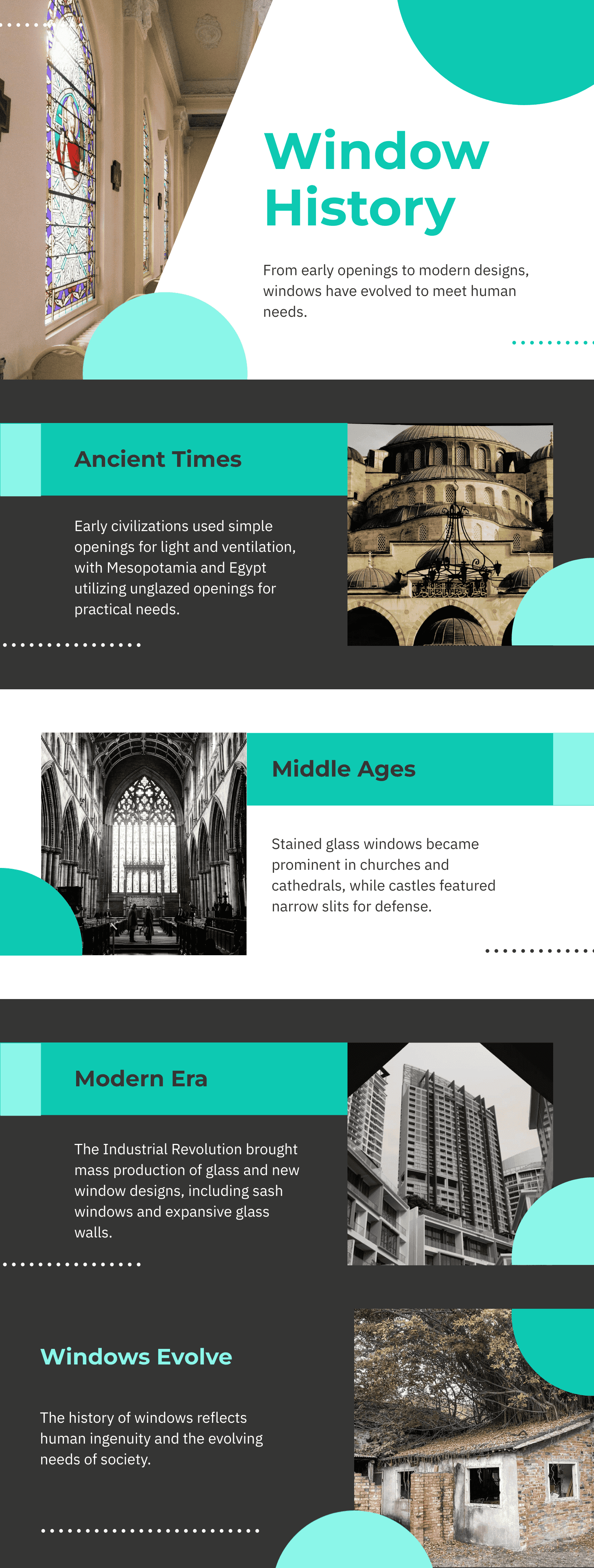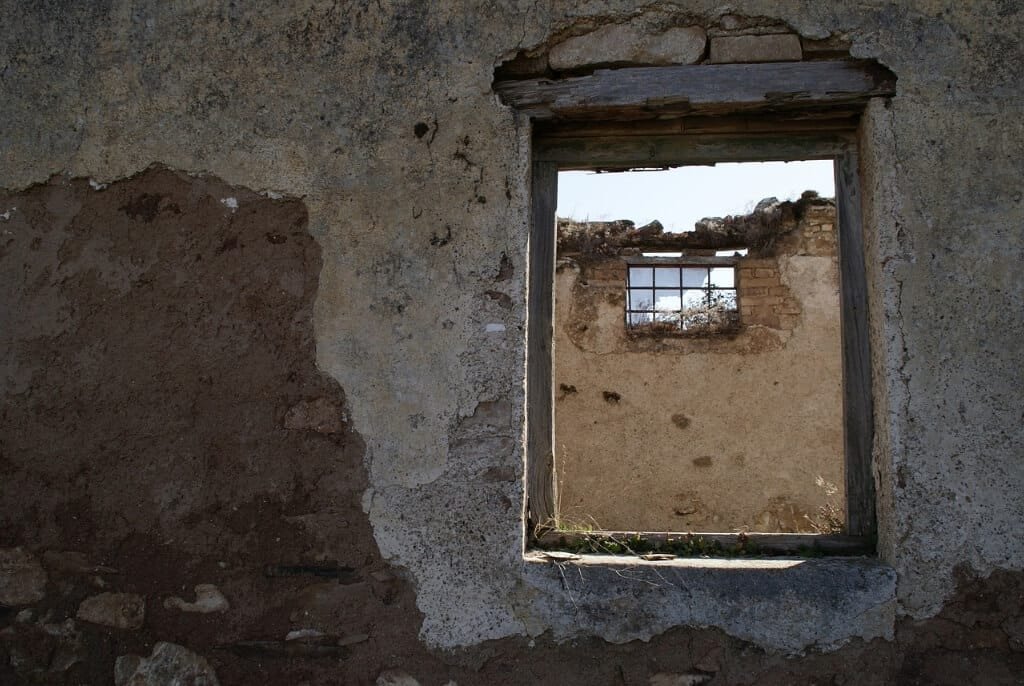Windows have been integral to architectural design for centuries, providing both practical and aesthetic benefits. From ancient openings to modern, energy-efficient panes, window evolution reflects technological advances and architectural style shifts. This article delves into the history of window inventions, tracing their development from primitive openings to contemporary innovations.

The Origin Of Windows: Early Beginnings
The concept of windows as we understand them today began with simple wall openings. Early humans, living in caves, used these natural apertures for light and ventilation. While these were not windows in the traditional sense, they served similar purposes, allowing light to enter and air to circulate.
In ancient civilizations, the idea of incorporating openings into structures continued to evolve. Archaeological sites reveal that these early adaptations laid the groundwork for what would become windows. For instance, some of the earliest evidence of window-like features can be found in prehistoric structures such as dwellings from the Neolithic era.
Ancient Civilizations And The Evolution Of Windows
As human societies developed, so did the architectural need for structures that could provide shelter, light, and ventilation. In ancient Mesopotamia, the early use of windows was evident in the design of ziggurats and residential buildings, which featured small, unglazed openings. These openings were strategically placed high on the walls to allow sunlight to enter while maintaining privacy and security. Meanwhile, in ancient Egypt, similar techniques were adopted in the design of temples and palaces, where narrow slits were used to let in light and cool the interiors. The Egyptians sometimes used cloth or wood to cover these openings, providing a rudimentary form of window treatment that balanced light and privacy. In ancient Greece, window design became more sophisticated, with architects incorporating larger openings and sometimes adding shutters to control the amount of light entering a space.
The Romans further advanced the evolution of windows by introducing glass into their architectural repertoire around the 1st century AD. Roman glassmakers developed techniques to produce small glass panes, which were installed in public buildings, baths, and the homes of the wealthy. These early glass windows not only allowed for more natural light but also offered protection from the elements, marking a significant step forward in the history of window inventions. Additionally, in ancient Asian civilizations such as China and Japan, windows took on unique cultural characteristics, with intricate wooden lattice designs and translucent rice paper coverings that allowed light to filter through softly, enhancing the interior ambiance. These diverse adaptations across different civilizations highlight the growing importance of windows in architectural design and their evolving functionality and aesthetics.
Mesopotamia And Ancient Egypt
The first recorded use of windows in ancient civilizations appears in Mesopotamia and Egypt. Early Mesopotamian ziggurats and Egyptian temples included unglazed openings to let in light while protecting the interior from harsh elements. These early windows were often covered with wooden shutters or woven materials to provide privacy and security.
In the ancient civilizations of Mesopotamia and Egypt, the early development of window openings played a crucial role in architectural design. In Mesopotamia, one of the world’s earliest urban societies, builders incorporated small, unglazed openings high in the walls of their mud-brick structures. These openings allowed for ventilation and daylight to penetrate the interiors, which were often dark and enclosed due to the thick walls used for temperature regulation. The strategic placement of these openings provided necessary airflow in the hot climate, making indoor environments more comfortable. In ancient Egypt, similar practices were evident in the grand architecture of temples and palaces.
Egyptians utilized narrow slits and small openings in the upper sections of their massive stone walls, allowing sunlight to enter sacred spaces in a controlled manner, creating dramatic lighting effects that played a significant role in religious rituals. These slits were sometimes covered with wooden screens or reed mats, offering protection from dust and insects while still permitting light and airflow. The architectural innovations of both Mesopotamia and Egypt laid foundational principles for the use of windows in buildings, demonstrating an early understanding of how openings could be used not only for practical purposes but also to enhance the aesthetic and spiritual experience of a space. These ancient window designs reflect the ingenuity of these early societies in adapting their architecture to their environmental and cultural needs.
The Greek And Roman Influence
The Greeks and Romans were pivotal in the evolution of windows. Roman architecture, for instance, saw the introduction of glazed windows around the 1st century AD. These early panes of glass were small and used primarily in affluent homes and public buildings, like the ones unearthed in Pompeii. The Romans’s innovation in glass production marked a significant advancement in window technology, leading to more refined and functional designs.

Windows In Ancient Asia
Ancient Asian civilizations also made significant contributions to the history of windows. In China, windows were often designed with intricate wooden latticework, while in Japan, rice paper was used in sliding panels known as shoji. These materials provided privacy while allowing natural light to filter through, showcasing an early understanding of the balance between light and privacy.
Windows In The Middle Ages
During the medieval period, the design and function of windows continued to evolve. Churches and cathedrals, with their grand architecture, played a crucial role in advancing window technology. Stained glass windows became prominent during this era, adding both color and grandeur to religious buildings.
The Middle Ages marked a period of significant change and diversification in window design, driven by both functional needs and artistic expression. In religious architecture, particularly in the great cathedrals of Europe, windows became canvases for intricate stained glass artwork that depicted biblical stories, saints, and religious symbolism. These stained glass windows served multiple purposes: they illuminated the dark interiors of massive stone churches, filled the spaces with vibrant colors that shifted with the changing daylight, and educated congregants, many of whom were illiterate, through visual storytelling. In addition to their religious function, stained glass windows demonstrated the wealth and power of the church, as the production of such windows required skilled artisans and considerable financial resources.
Meanwhile, in secular and defensive architecture, such as castles and fortified manor houses, the design of windows reflected a priority for safety and defense. Narrow, vertical slits known as arrow loops or embrasures were common; these allowed defenders to shoot arrows while remaining protected from enemy attacks. As medieval societies grew and urbanized, residential buildings also began to incorporate larger windows, although these were still relatively small by modern standards and often covered with wooden shutters or animal hides to protect against the elements. By the late Middle Ages, the invention of leaded glass windows allowed for greater design flexibility, leading to more elaborate window patterns and the incorporation of small, diamond-shaped glass panes set within a lead framework. This innovation marked a significant step toward the widespread use of glass in window construction, paving the way for more light-filled interiors and the eventual transition to the Renaissance architectural styles that followed.
In castles and fortifications, windows were designed with a focus on security. Smaller, narrow openings, often referred to as arrow slits or loopholes, provided minimal exposure to the outside while allowing defenders to shoot arrows or observe from within. This practical design emphasized protection over aesthetics.
Renaissance And The Birth Of Modern Windows
The Renaissance period brought about a transformation in architectural design, including windows. The introduction of larger glass panes allowed for more light and better views, reflecting a shift towards more open and airy spaces. This era saw the rise of decorative window designs, including the use of intricate window grilles and elaborate frames.
Influential architects of the Renaissance, such as Andrea Palladio and Michelangelo, incorporated these advancements into their designs. The use of large, symmetrical windows became a hallmark of Renaissance architecture, signifying a new appreciation for natural light and visual aesthetics.

The Industrial Revolution: A Window To New Possibilities
The Industrial Revolution marked a turning point in window design. The mass production of glass and the development of new manufacturing techniques revolutionized the construction industry. This era introduced sash windows with multiple panes, which were both practical and aesthetically pleasing.
With the rise of urbanization, large-scale glass windows became prevalent in commercial and residential buildings. Innovations such as steel frames and plate glass enabled the creation of expansive window walls, transforming the appearance and functionality of buildings.
The Invention Of Modern Windows: 20th Century Onwards
The 20th century marked a transformative era in the history of window inventions, characterized by technological breakthroughs and new architectural philosophies. The development of float glass technology revolutionized the production process, allowing for the creation of large, uniform glass panes with unprecedented clarity and strength. This innovation made it possible to design buildings with expansive glass facades, which became a hallmark of modernist architecture. Architects such as Ludwig Mies van der Rohe and Walter Gropius championed the use of glass to blur the lines between indoor and outdoor spaces, fostering a sense of openness and connection to the environment. Beyond aesthetics, advancements in glass manufacturing also addressed practical concerns. The introduction of double glazing significantly improved energy efficiency by providing better insulation, reducing heat loss in winter, and keeping interiors cooler in summer.
The rise of urban high-rise buildings saw the incorporation of curtain walls and external coverings of a building that are not structural but designed to keep out weather elements often composed entirely of glass. These developments not only transformed the visual appearance of cities but also impacted how people interacted with their surroundings, offering panoramic views and abundant natural light. Additionally, the 20th century witnessed the emergence of smart glass technology, capable of dynamically changing its properties, such as tint and transparency, in response to environmental conditions. These innovations reflect the ongoing evolution of window design, balancing aesthetics, functionality, and sustainability to meet the demands of modern living.
Innovations In Glass Technology
The 20th century brought significant advancements in glass technology. Float glass, developed in the 1950s, allowed for the production of large, flawless panes. This innovation facilitated the creation of modern skyscrapers and other architectural marvels with expansive glass facades.
Double glazing emerged as a crucial development for energy efficiency, providing better insulation and reducing heat loss. This technology has become a standard feature in modern windows, enhancing comfort and sustainability in buildings.
The Influence Of Modern Architecture
Modernist architects such as Le Corbusier and Frank Lloyd Wright were instrumental in redefining window design. Their use of floor-to-ceiling windows and curtain walls became iconic, reflecting a shift towards open, light-filled spaces. These design principles continue to influence contemporary architecture.
Energy Efficiency And Smart Windows
In recent years, there has been a growing focus on energy-efficient windows. Advances in window coatings and materials have led to the development of smart windows, which can adjust their tint and transparency in response to sunlight and temperature changes. This innovation represents a significant leap forward in integrating technology with architectural design.
Growing concerns about environmental sustainability and rising energy costs have spurred significant innovations in window technology, particularly in the development of energy-efficient and smart windows. Double and triple glazing became standard in many parts of the world, significantly enhancing a building’s insulation by creating a barrier that reduces heat loss in the winter and keeps interiors cooler during the summer months. This design not only improves comfort but also lowers energy consumption, as less heating and air conditioning are required to maintain a stable indoor temperature. Moreover, advances in low-emissivity (Low-E) coatings have further enhanced energy efficiency. These ultra-thin metallic layers reflect infrared radiation, keeping heat inside during cold weather and blocking external heat during hot weather, while still allowing natural light to pass through.
Beyond traditional efficiency measures, the advent of smart windows has marked a new frontier in window technology. These windows can change their properties dynamically, using electrochromic, thermochromic, or photochromic technologies to adjust their tint based on external conditions, such as sunlight intensity or indoor temperatures. Some smart windows can even be controlled manually or programmed to respond to specific environmental triggers, offering both convenience and additional energy savings. By integrating sensors and automation, smart windows contribute to the overall intelligence of modern buildings, optimizing natural light, enhancing comfort, and reducing reliance on artificial lighting and climate control systems. As green building standards become more prevalent, the adoption of these innovative window technologies is likely to grow, playing a crucial role in the push towards more sustainable and energy-efficient living and working environments.

The Future Of Windows: Trends And Innovations
Looking ahead, the future of Windows is shaped by trends towards sustainability and technological innovation. New materials and designs aim to improve energy efficiency and environmental impact. Innovations such as self-cleaning glass and integrated photovoltaic cells are paving the way for smarter, more eco-friendly windows.
As technology continues to evolve, windows are expected to play an increasingly important role in creating sustainable and intelligent buildings. The integration of advanced features and materials will likely transform how we interact with our built environments.
Cultural And Aesthetic Significance Of Windows
Windows have also held significant cultural and aesthetic value throughout history. In art and literature, they often symbolize insight, reflection, and connection to the outside world. The design of windows can influence how spaces are perceived and experienced, contributing to the overall ambiance of a building.
Different cultures have incorporated unique window designs into their architectural traditions. For example, the elaborate stained glass windows of European cathedrals contrast with the minimalist, functional designs found in modern Japanese architecture. These variations highlight the diverse ways in which windows can enhance both the functionality and beauty of a space.
Final Thoughts
The history of window inventions is a fascinating journey through time, reflecting the evolution of architectural and technological advancements. From early openings in prehistoric structures to sophisticated modern designs, windows have continually adapted to meet the needs of society. Their development is a testament to human ingenuity and the ongoing quest to enhance the way we experience our built environments.
As we look to the future, windows will undoubtedly continue to evolve, integrating new technologies and materials to improve functionality, sustainability, and aesthetics. Understanding the history of window inventions enriches our appreciation of these everyday elements of architecture and their impact on our lives.
FAQs
When Were The First Glass Windows Used?
The first recorded use of glass windows dates back to the 1st century AD in Roman architecture. These early panes were small and primarily used in affluent homes and public buildings.
How Did Windows Evolve During The Middle Ages?
During the Middle Ages, windows became more decorative in churches and cathedrals with stained glass, while castles featured narrow openings for defensive purposes.
What Is The Significance Of Float Glass In Modern Window Technology?
Float glass, developed in the 1950s, allowed for the production of large, clear panes, revolutionizing window design and enabling the creation of modern glass facades in skyscrapers and other buildings.
What Are Smart Windows And How Do They Work?
Smart windows are designed to adjust their tint and transparency based on external conditions like sunlight and temperature. They use technologies such as electrochromic coatings or liquid crystal displays to improve energy efficiency and comfort.
How Do Modern Windows Contribute To Energy Efficiency?
Modern windows often feature double or triple glazing, low-emissivity coatings, and gas fills to reduce heat loss and improve insulation. These features help maintain indoor temperatures and reduce energy consumption.
Also Read: How Did People Shave Before The Invention Of A Safety Razor?
